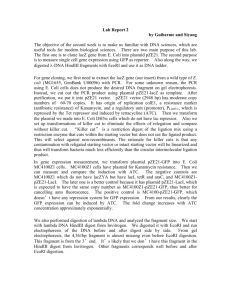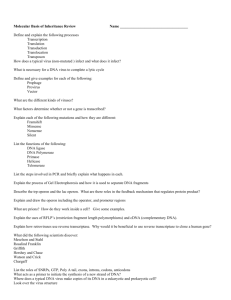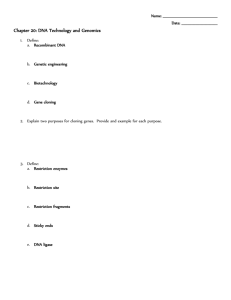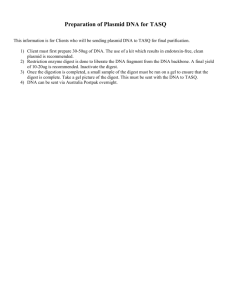Experiment 7: Analysis of Plasmid DNA by Restriction
advertisement
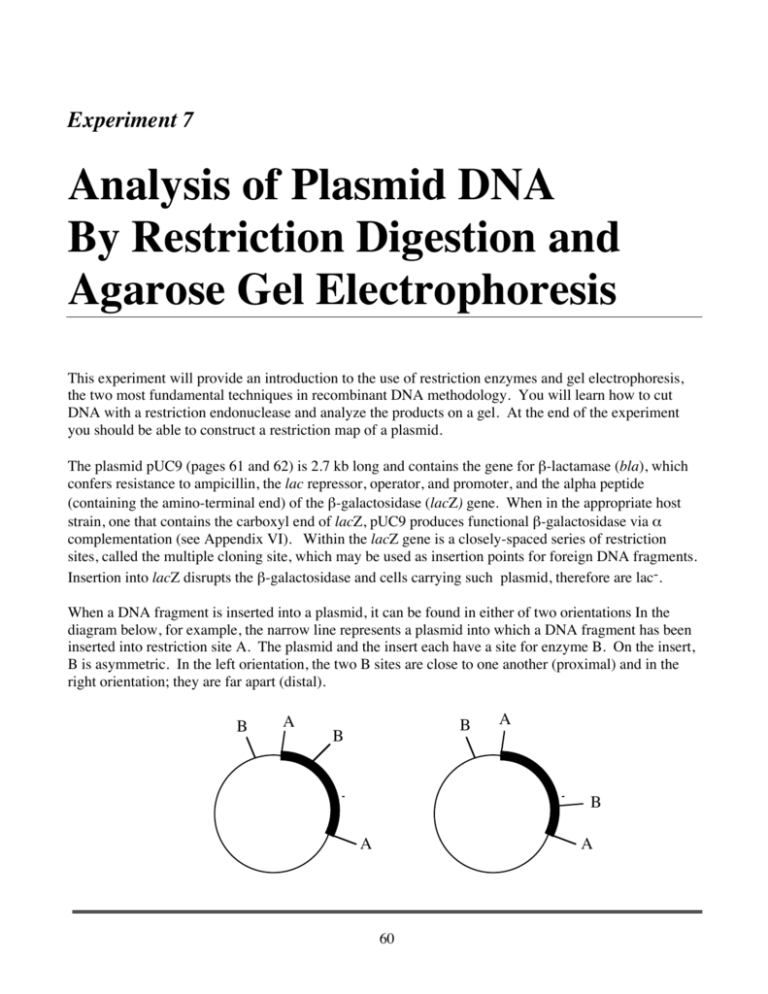
Experiment 7 Analysis of Plasmid DNA By Restriction Digestion and Agarose Gel Electrophoresis This experiment will provide an introduction to the use of restriction enzymes and gel electrophoresis, the two most fundamental techniques in recombinant DNA methodology. You will learn how to cut DNA with a restriction endonuclease and analyze the products on a gel. At the end of the experiment you should be able to construct a restriction map of a plasmid. The plasmid pUC9 (pages 61 and 62) is 2.7 kb long and contains the gene for β-lactamase (bla), which confers resistance to ampicillin, the lac repressor, operator, and promoter, and the alpha peptide (containing the amino-terminal end) of the β-galactosidase (lacZ) gene. When in the appropriate host strain, one that contains the carboxyl end of lacZ, pUC9 produces functional β-galactosidase via α complementation (see Appendix VI). Within the lacZ gene is a closely-spaced series of restriction sites, called the multiple cloning site, which may be used as insertion points for foreign DNA fragments. Insertion into lacZ disrupts the β-galactosidase and cells carrying such plasmid, therefore are lac-. When a DNA fragment is inserted into a plasmid, it can be found in either of two orientations In the diagram below, for example, the narrow line represents a plasmid into which a DNA fragment has been inserted into restriction site A. The plasmid and the insert each have a site for enzyme B. On the insert, B is asymmetric. In the left orientation, the two B sites are close to one another (proximal) and in the right orientation; they are far apart (distal). B A B B A B A A 60 Analysis of Plasmid DNA If both of these plasmids are cut with enzyme A, the vector and insert fragments will be regenerated. Both orientations will produce exactly the same fragments. However, if the plasmids are cut with enzyme B, the resulting fragments will be different. The proximal orientation will produce a large and a small fragment while the distal orientation will produce two moderately sized fragments: pRHR30 is a derivative of pUC9 in which a fragment of human DNA has been inserted into the EcoRI site in lacZ. The fragment has an asymmetric HindIII site that is either proximal or distal to the HindIII site on pUC9. In this experiment, you will cut pUC9 and pRHR30 with EcoRI, HindIII, and BamHI and construct a plasmid map. The results of this experiment will be combined with Experiment 2 for your first formal lab report. Note that in addition to the restriction digests done in this experiment, you will also perform several restriction digests that will be used for Experiment 9. 61 Experiment 7 Procedure 1. Prepare the series of restriction digests described below according to the procedure on page 12. You will use 5 µl of DNA and 15 µl of reaction mix. Note: The DNA and water volumes are generic. The exact amount of DNA sample to be added depends on the DNA concentration, which varies from year to year with different DNA preps. The concentration of this year’s DNA can be found in the class syllabus. During lab you will be told how much DNA sample to actually use, and you must adjust the amount of water accordingly so that DNA + water = 18 µ l Tube 1 2 3 4 5 DNA pUC9 (5 µl) “ “ “ “ 6 7 1 kb ladder (3 µl) λ HindIII (3 µl) 8 9 10 11 12 pRHR30 (5 µl) “ “ “ “ Enzyme none HindIII BamHI EcoRI PstI Buffer (2 µl) none Med Med High Med Water 15 µl 13 µl “ “ “ * Dye Blue “ “ “ “ none none none none 17 µl 17 µl “ Orange none HindIII BamHI EcoRI PstI none Med Med High Med 15 µl 13 µl “ “ “ “ “ “ “ “ *Tracking dye (5 µl) is added AFTER the incubation period 2. Prepare the restriction digests and heat inactivation for steps 1 and 2 of Experiment 9. 3. Place samples 2-5 and 9-12 in a 37o water bath for 40 minutes. 4. While you are waiting for your DNA’s to digest, pour a 1% agarose gel according to the procedure on page 21. 5. At the end of 40 minutes, remove the samples and add 5 µl of tracking dye to each sample. 62 Analysis of Plasmid DNA Analysis 6. Load the entire 25 µl onto the gel and run at 120 volts for about 90 minutes. The orange tracking dye should run at least half way down the gel. 7. Take a cell phone photograph to document the migration of the tracking dyes. 8. Stain your gel with Gel Red and photograph. 1. Measure the distance that each band migrated from the origin and record the results in a table. 2. Graph the migration of your molecular weight standards (samples 6 and 7) on semi-log paper. Plot log kb versus distance. This will be your standard curve. I will examine your standard curves to make sure that they are plotted correctly. 3. When your standard curve is correct, plot the distances of your cut samples on the curve and determine the size of each fragment. Record the migration distances and molecular weights in a table. 4. Construct a map for pRHR30 63 Experiment 7 64 Analysis of Plasmid DNA 65
